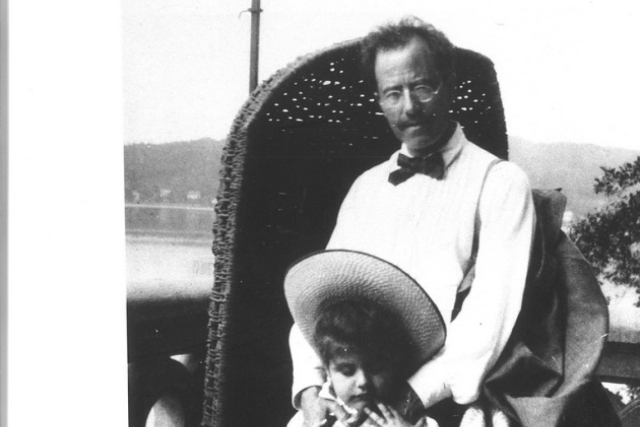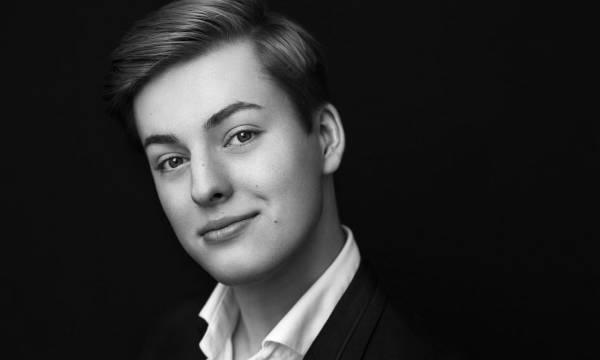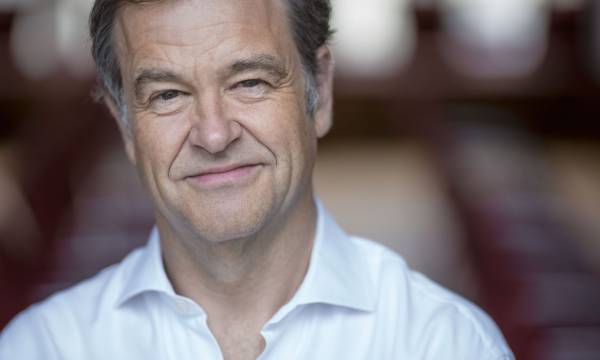
Mahler Festival: Fleur Barron, Laurence Kilsby and Julius Drake in Mahler's songs (English)
Recital Hall 15 mei 2025 13.00 uur
Fleur Barron mezzo-soprano
Laurence Kilsby tenor
Julius Drake piano
Lyrics are available for free in the hall.
Also interesting:
- Did Mahler base his songs on his life?
- Julius Drake on Mahler's songs
Gustav Mahler (1860-1911)
Lieder und Gesänge from ‘Des Knaben Wunderhorn’ (1887-90)
Um schlimme Kinder artig zu machen
Ich ging mit Lust durch einen grünen Wald
Aus! Aus!
Starke Einbildungskraft
Zu Straßburg auf der Schanz
Ablösung im Sommer
Selbstgefühl
Nicht wiedersehen!
Scheiden und Meiden
Kindertotenlieder (1901-04)
Nun will die Sonn’ so hell aufgeh’n
Nun seh’ ich wohl, warum so dunkle Flammen
Wenn dein Mütterlein
Oft denk’ ich, sie sind nur ausgegangen
In diesem Wetter, in diesem Braus
no interval
end ± 2.00PM
Fleur Barron mezzo-soprano
Laurence Kilsby tenor
Julius Drake piano
Lyrics are available for free in the hall.
Also interesting:
- Did Mahler base his songs on his life?
- Julius Drake on Mahler's songs
Gustav Mahler (1860-1911)
Lieder und Gesänge from ‘Des Knaben Wunderhorn’ (1887-90)
Um schlimme Kinder artig zu machen
Ich ging mit Lust durch einen grünen Wald
Aus! Aus!
Starke Einbildungskraft
Zu Straßburg auf der Schanz
Ablösung im Sommer
Selbstgefühl
Nicht wiedersehen!
Scheiden und Meiden
Kindertotenlieder (1901-04)
Nun will die Sonn’ so hell aufgeh’n
Nun seh’ ich wohl, warum so dunkle Flammen
Wenn dein Mütterlein
Oft denk’ ich, sie sind nur ausgegangen
In diesem Wetter, in diesem Braus
no interval
end ± 2.00PM
Toelichting
Gustav Mahler (1860-1911)
Songs from ‘Des Knaben Wunderhorn’
In Gustav Mahler’s oeuvre, song and symphony are intimately linked. This connection is especially evident in the period between 1880-1900, known as the ‘Wunderhorn years,’ when Mahler composed not only his first four symphonies but the Lieder eines fahrenden Gesellen and songs based on texts from the Des Knaben Wunderhorn (‘The Boy’s Magic Horn’) anthology. Mahler’s symphonic works from this time are suffused with the same folkloric quality as his songs, either in the form of a distant echo or a direct quote. In a few cases, Mahler transferred his songs in their entirety to a symphony (Urlicht, Des Antonius von Padua Fischpredigt, Es sungen Drei Engel).
Mahler’s selection of texts from Des Knaben Wunderhorn also reveals something about his youthful memories. He grew up in what was then the Moravian garrison city of Iglau (now Jihlava). There Mahler became familiar with soldiers playing their music while marching past the barracks. However, the ‘military’ texts found in Des Knaben Wunderhorn are far from triumphant. Revelge (‘Reveille’: ‘Ich muss marschieren’) is one poignant example; it deals with a fatally injured drummer boy. In Der Tamboursg’sell (‘The Drummer Boy’) a comrade-in-arms receives a death sentence for desertion. Sometimes, Mahler skilfully unites declarations of love with martial music, as in Wo die schönen Trompeten blasen, but these poems have a decidedly pacifistic tone.
Each of the songs in this cycle has its own orchestra, as it were, in which different instruments come to the fore, lending each song an ever-changing colour palette. Later, Mahler would expand his use of martial rhythms and trumpet calls, and along the way, the Ländler (Rheinlegendchen), a dance of the ‘common folk’, would gradually lose its innocence. Almost everything that makes Mahler a Mahler can already be found here.
Translation: Josh Dillon
In Gustav Mahler’s oeuvre, song and symphony are intimately linked. This connection is especially evident in the period between 1880-1900, known as the ‘Wunderhorn years,’ when Mahler composed not only his first four symphonies but the Lieder eines fahrenden Gesellen and songs based on texts from the Des Knaben Wunderhorn (‘The Boy’s Magic Horn’) anthology. Mahler’s symphonic works from this time are suffused with the same folkloric quality as his songs, either in the form of a distant echo or a direct quote. In a few cases, Mahler transferred his songs in their entirety to a symphony (Urlicht, Des Antonius von Padua Fischpredigt, Es sungen Drei Engel).
Mahler’s selection of texts from Des Knaben Wunderhorn also reveals something about his youthful memories. He grew up in what was then the Moravian garrison city of Iglau (now Jihlava). There Mahler became familiar with soldiers playing their music while marching past the barracks. However, the ‘military’ texts found in Des Knaben Wunderhorn are far from triumphant. Revelge (‘Reveille’: ‘Ich muss marschieren’) is one poignant example; it deals with a fatally injured drummer boy. In Der Tamboursg’sell (‘The Drummer Boy’) a comrade-in-arms receives a death sentence for desertion. Sometimes, Mahler skilfully unites declarations of love with martial music, as in Wo die schönen Trompeten blasen, but these poems have a decidedly pacifistic tone.
Each of the songs in this cycle has its own orchestra, as it were, in which different instruments come to the fore, lending each song an ever-changing colour palette. Later, Mahler would expand his use of martial rhythms and trumpet calls, and along the way, the Ländler (Rheinlegendchen), a dance of the ‘common folk’, would gradually lose its innocence. Almost everything that makes Mahler a Mahler can already be found here.
Translation: Josh Dillon
Gustav Mahler (1860-1911)
Kindertotenlieder
Friedrich Rückert (1788-1866) wrote more than four hundred poems in his attempt to come to terms with the deaths of his two children. Gustav Mahler chose five of these poems; he wrote the first three of his Kindertotenlieder in the summer of 1901 in Maiernigg. The two remaining songs were composed in 1904, during his summer holiday. In the intervening years, Mahler had married Alma Maria Schindler, and on 30 November 1902, their daughter, Maria, nicknamed Putzi, was born. Mahler’s Kindertotenlieder (Songs on the Death of Children) are often seen as foreshadowing Putzi’s death on 5 July 1907, an idea derived from Alma Mahler’s book, Gustav Mahler, Memories and Letters (1946), in which she blames her husband for tempting fate by choosing these Rückert poems. A more likely scenario, however, is that Mahler simply felt a purely expressive empathy with a man who was coping with the loss of his children. In this, Mahler also drew on his childhood memories, especially those of the death of his brother.
Friedrich Rückert (1788-1866) wrote more than four hundred poems in his attempt to come to terms with the deaths of his two children. Gustav Mahler chose five of these poems; he wrote the first three of his Kindertotenlieder in the summer of 1901 in Maiernigg. The two remaining songs were composed in 1904, during his summer holiday. In the intervening years, Mahler had married Alma Maria Schindler, and on 30 November 1902, their daughter, Maria, nicknamed Putzi, was born. Mahler’s Kindertotenlieder (Songs on the Death of Children) are often seen as foreshadowing Putzi’s death on 5 July 1907, an idea derived from Alma Mahler’s book, Gustav Mahler, Memories and Letters (1946), in which she blames her husband for tempting fate by choosing these Rückert poems. A more likely scenario, however, is that Mahler simply felt a purely expressive empathy with a man who was coping with the loss of his children. In this, Mahler also drew on his childhood memories, especially those of the death of his brother.
In Nun, die Sonn’ so hell aufgeh’n, the vocalist (usually a baritone or mezzo-soprano) subtly underlines the father’s crushing sadness. The second song, Nun seh’ ich wohl, is characterized by agitation, doubt and painful delusions. The highly recognizable state of denial is at the heart of the moving Wenn dein Mütterlein, in which the childlike simplicity of the melody recalls a Moravian folk song. In Oft denk’ ich, sie sind nur ausgegangen, the father imagines his children have simply gone on an extended hike in the mountains and are reluctant to return home. The closing measures are bathed in an all-encompassing, loving light. In the final song, however, despair and anger gain the upper hand. A devastating thunderstorm symbolizes the inner wrestling of the mourning parent. In the end, a tender lullaby emerges to offer heavenly solace.
Translation: Josh Dillon
In Nun, die Sonn’ so hell aufgeh’n, the vocalist (usually a baritone or mezzo-soprano) subtly underlines the father’s crushing sadness. The second song, Nun seh’ ich wohl, is characterized by agitation, doubt and painful delusions. The highly recognizable state of denial is at the heart of the moving Wenn dein Mütterlein, in which the childlike simplicity of the melody recalls a Moravian folk song. In Oft denk’ ich, sie sind nur ausgegangen, the father imagines his children have simply gone on an extended hike in the mountains and are reluctant to return home. The closing measures are bathed in an all-encompassing, loving light. In the final song, however, despair and anger gain the upper hand. A devastating thunderstorm symbolizes the inner wrestling of the mourning parent. In the end, a tender lullaby emerges to offer heavenly solace.
Translation: Josh Dillon
Gustav Mahler (1860-1911)
Songs from ‘Des Knaben Wunderhorn’
In Gustav Mahler’s oeuvre, song and symphony are intimately linked. This connection is especially evident in the period between 1880-1900, known as the ‘Wunderhorn years,’ when Mahler composed not only his first four symphonies but the Lieder eines fahrenden Gesellen and songs based on texts from the Des Knaben Wunderhorn (‘The Boy’s Magic Horn’) anthology. Mahler’s symphonic works from this time are suffused with the same folkloric quality as his songs, either in the form of a distant echo or a direct quote. In a few cases, Mahler transferred his songs in their entirety to a symphony (Urlicht, Des Antonius von Padua Fischpredigt, Es sungen Drei Engel).
Mahler’s selection of texts from Des Knaben Wunderhorn also reveals something about his youthful memories. He grew up in what was then the Moravian garrison city of Iglau (now Jihlava). There Mahler became familiar with soldiers playing their music while marching past the barracks. However, the ‘military’ texts found in Des Knaben Wunderhorn are far from triumphant. Revelge (‘Reveille’: ‘Ich muss marschieren’) is one poignant example; it deals with a fatally injured drummer boy. In Der Tamboursg’sell (‘The Drummer Boy’) a comrade-in-arms receives a death sentence for desertion. Sometimes, Mahler skilfully unites declarations of love with martial music, as in Wo die schönen Trompeten blasen, but these poems have a decidedly pacifistic tone.
Each of the songs in this cycle has its own orchestra, as it were, in which different instruments come to the fore, lending each song an ever-changing colour palette. Later, Mahler would expand his use of martial rhythms and trumpet calls, and along the way, the Ländler (Rheinlegendchen), a dance of the ‘common folk’, would gradually lose its innocence. Almost everything that makes Mahler a Mahler can already be found here.
Translation: Josh Dillon
In Gustav Mahler’s oeuvre, song and symphony are intimately linked. This connection is especially evident in the period between 1880-1900, known as the ‘Wunderhorn years,’ when Mahler composed not only his first four symphonies but the Lieder eines fahrenden Gesellen and songs based on texts from the Des Knaben Wunderhorn (‘The Boy’s Magic Horn’) anthology. Mahler’s symphonic works from this time are suffused with the same folkloric quality as his songs, either in the form of a distant echo or a direct quote. In a few cases, Mahler transferred his songs in their entirety to a symphony (Urlicht, Des Antonius von Padua Fischpredigt, Es sungen Drei Engel).
Mahler’s selection of texts from Des Knaben Wunderhorn also reveals something about his youthful memories. He grew up in what was then the Moravian garrison city of Iglau (now Jihlava). There Mahler became familiar with soldiers playing their music while marching past the barracks. However, the ‘military’ texts found in Des Knaben Wunderhorn are far from triumphant. Revelge (‘Reveille’: ‘Ich muss marschieren’) is one poignant example; it deals with a fatally injured drummer boy. In Der Tamboursg’sell (‘The Drummer Boy’) a comrade-in-arms receives a death sentence for desertion. Sometimes, Mahler skilfully unites declarations of love with martial music, as in Wo die schönen Trompeten blasen, but these poems have a decidedly pacifistic tone.
Each of the songs in this cycle has its own orchestra, as it were, in which different instruments come to the fore, lending each song an ever-changing colour palette. Later, Mahler would expand his use of martial rhythms and trumpet calls, and along the way, the Ländler (Rheinlegendchen), a dance of the ‘common folk’, would gradually lose its innocence. Almost everything that makes Mahler a Mahler can already be found here.
Translation: Josh Dillon
Gustav Mahler (1860-1911)
Kindertotenlieder
Friedrich Rückert (1788-1866) wrote more than four hundred poems in his attempt to come to terms with the deaths of his two children. Gustav Mahler chose five of these poems; he wrote the first three of his Kindertotenlieder in the summer of 1901 in Maiernigg. The two remaining songs were composed in 1904, during his summer holiday. In the intervening years, Mahler had married Alma Maria Schindler, and on 30 November 1902, their daughter, Maria, nicknamed Putzi, was born. Mahler’s Kindertotenlieder (Songs on the Death of Children) are often seen as foreshadowing Putzi’s death on 5 July 1907, an idea derived from Alma Mahler’s book, Gustav Mahler, Memories and Letters (1946), in which she blames her husband for tempting fate by choosing these Rückert poems. A more likely scenario, however, is that Mahler simply felt a purely expressive empathy with a man who was coping with the loss of his children. In this, Mahler also drew on his childhood memories, especially those of the death of his brother.
Friedrich Rückert (1788-1866) wrote more than four hundred poems in his attempt to come to terms with the deaths of his two children. Gustav Mahler chose five of these poems; he wrote the first three of his Kindertotenlieder in the summer of 1901 in Maiernigg. The two remaining songs were composed in 1904, during his summer holiday. In the intervening years, Mahler had married Alma Maria Schindler, and on 30 November 1902, their daughter, Maria, nicknamed Putzi, was born. Mahler’s Kindertotenlieder (Songs on the Death of Children) are often seen as foreshadowing Putzi’s death on 5 July 1907, an idea derived from Alma Mahler’s book, Gustav Mahler, Memories and Letters (1946), in which she blames her husband for tempting fate by choosing these Rückert poems. A more likely scenario, however, is that Mahler simply felt a purely expressive empathy with a man who was coping with the loss of his children. In this, Mahler also drew on his childhood memories, especially those of the death of his brother.
In Nun, die Sonn’ so hell aufgeh’n, the vocalist (usually a baritone or mezzo-soprano) subtly underlines the father’s crushing sadness. The second song, Nun seh’ ich wohl, is characterized by agitation, doubt and painful delusions. The highly recognizable state of denial is at the heart of the moving Wenn dein Mütterlein, in which the childlike simplicity of the melody recalls a Moravian folk song. In Oft denk’ ich, sie sind nur ausgegangen, the father imagines his children have simply gone on an extended hike in the mountains and are reluctant to return home. The closing measures are bathed in an all-encompassing, loving light. In the final song, however, despair and anger gain the upper hand. A devastating thunderstorm symbolizes the inner wrestling of the mourning parent. In the end, a tender lullaby emerges to offer heavenly solace.
Translation: Josh Dillon
In Nun, die Sonn’ so hell aufgeh’n, the vocalist (usually a baritone or mezzo-soprano) subtly underlines the father’s crushing sadness. The second song, Nun seh’ ich wohl, is characterized by agitation, doubt and painful delusions. The highly recognizable state of denial is at the heart of the moving Wenn dein Mütterlein, in which the childlike simplicity of the melody recalls a Moravian folk song. In Oft denk’ ich, sie sind nur ausgegangen, the father imagines his children have simply gone on an extended hike in the mountains and are reluctant to return home. The closing measures are bathed in an all-encompassing, loving light. In the final song, however, despair and anger gain the upper hand. A devastating thunderstorm symbolizes the inner wrestling of the mourning parent. In the end, a tender lullaby emerges to offer heavenly solace.
Translation: Josh Dillon
Biografie
Fleur Barron, mezzo-soprano
Fleur Barron has English/Singaporean roots, was born in Ireland, grew up in Hong Kong and lives in London. She received a bachelor’s degree in comparative literature from Columbia University in New York before graduating from the Manhattan School of Music.
Currently coached by Barbara Hannigan, the mezzo-soprano has become a passionate interpreter of opera, lieder and concert repertoire from baroque to contemporary. She is currently an artistic partner of the Orquesta Sinfonica del Principado de Asturias in Oviedo.
This season is her Mahler year, marking debuts with a variety of orchestras singing Das Lied von der Erde, Des Knaben Wunderhorn, the Second Symphony and the Rückert-Lieder.
In 2023 she made two Concertgebouw debuts within a month, in both the Main Hall and Recital Hall. With pianist Julius Drake, she has performed in the Recital Hall, in Wigmore Hall (London), Stuttgart, Madrid, Manchester and Oviedo.
Laurence Kilsby, tenor
Laurence Kilsby – a ‘Young Singer’ nominee during the International Opera Awards 2023 – won first prize at three international competitions. His debut album Awakenings, with pianist Ella O’Neill, was recently released. Kilsby began his career as a boy soprano at the Tewkesbury Abbey Schola Cantorum.
Later he studied at the Royal College of Music in London and at the Curtis Institute of Music in Philadelphia. Currently the British tenor is making waves on opera and concert stages, as well as in lieder recitals.
He has returned to The Concertgebouw twice since his debut in 2022 in Bach’s Johannes-Passion with the Orchestra and Choir of the Age of Enlightenment. His first performance in the Recital Hall will be during the Mahler Festival.
Julius Drake, piano
Julius Drake enjoys an international reputation as one of today’s best song accompanists. His passion for art song has resulted in invitations from The Concertgebouw, London’s Wigmore Hall and the BBC, among others, to put together song recital series.
He organises an annual recital series in London’s historic Middle Temple Hall, Julius Drake and Friends, where he is joined by outstanding singers including Sir Thomas Allen, Véronique Gens, Simon Keenlyside and Felicity Lott. Drake has made recordings with many artists, including Gerard Finley, Ian Bostridge and Christianne Stotijn.
He received his education at the Purcell School and the Royal College of Music in London. He currently teaches piano/song accompaniment at the Kunstuniversität Graz in Austria. In December 2022 Drake was awarded the Concertgebouw Medal.



